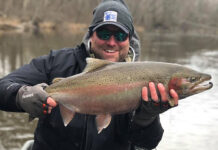In January, I did most of my wildlife watching through my office windows. Though the bird feeders were always busy, I also noticed a frenzy of activity among the gray and fox squirrels that inhabit the nearby woods.
Chase begins
On all but the coldest and snowiest days, I could count on seeing two squirrels chasing a third. For as long as an hour, the single-file pursuit continued — up one tree, down another, along a fallen log. After a short rest to devour an acorn or grab a few sunflower seeds, the chase resumed.
All the while, the squirrels scolded each other with a repetitious series of guttural barks. These “squirrel races” were much more than friendly fun. They actually represented one of the early stages of squirrel courtship.
Looking for mates
Male gray and fox squirrels, the common tree squirrels of the eastern United States, begin to vie for mates in late December. Chasing females is an important part of the ritual. With occasional breaks for food and rest, these chases continue for several weeks. Eventually the female accepts the overtures of the male that stays closest to her.
In the woods, persistence pays dividends. Gray and Fox squirrels mate in January. The breeding biology of gray and Fox squirrels is similar. Gestation is surprisingly long for such small rodents.
Squirrel litters
Litters of two to five kits (average three) are born in a tree cavity lined with leaves 44 to 45 days after mating. Birthing peaks in mid-March. Newborn squirrels measure about two inches in length and weigh about one-half ounce. Development of the young is slow.
Baby squirrels open their eyes at four to five weeks and wean at about eight weeks. It’s usually May before young squirrels can be seen scampering in treetops. They remain with their mother another four to five weeks before she prods them to independence. By the time momma squirrel bounces the kids, she’s ready to start all over.
Chase resumes
Another series of chases ensues in early June and leads to a second litter in July or early August. In years following a poor nut crop or a severe winter, females forego the summer litter. Females breed when 1 year old, but produce only one litter that first year.
If you’re not familiar with them, gray and fox squirrels can be difficult to distinguish.
Grays are smaller, a pound and a half, and have an overall grayish cast that contrasts with a white belly. Their tails have a frosted look because the tips of the tail hairs are white. Fox squirrels weigh about two pounds, are a grizzled rusty brown, and have rusty bellies. Their tails are not frosted.
Not a common color
Melanistic forms of both species are not uncommon. “Black” squirrels are not distinct species; they are dark forms of gray and fox squirrels. Melanism, essentially an overdose of dark pigments, is under genetic control, so populations of black squirrels tend to be local and isolated.
When I was in graduate school, a population of “black” gray squirrels inhabited the campus of Michigan State University, and I’ve also seen black gray squirrels at Kent State University. I’ve rarely seen a black squirrel in a natural setting. Nature frowns on individuals that stand out in a crowd — they’re easy for predators to spot.
Gray and fox squirrels also prefer subtly different habitats. Grays prefer mature oak-hickory forests with dense understories. Fox squirrels prefer more open woods and wooded stream bottoms. Both species thrive in protected city parks. These habitat distinctions, however, are far from absolute, so don’t be surprised to find either species in any forest where oaks are common.
Wide open spaces
Fox squirrels typically require a larger home range than gray squirrels. This is due to the habitat differences between the two species. The more open habitat that fox squirrels prefer has fewer nut-bearing trees per acre than the denser forests that gray squirrels prefer.
Fewer trees means fox squirrels must roam more widely in search of food. Though nuts are squirrels favorite foods, they are not available in spring and early summer. At those times squirrels broadened their diet to include fruits, berries, fungi, corn, insects, bird eggs, and even small nestlings. When birds are nesting, squirrels can be serious nest predators.













There seems to be a lot of chatter on the internet about fox squirrels and grey squirrels interbreeding and creating hybrid offspring. I am a graduate student in wildlife science at Purdue and I have encountered several laypeople (while conducting my research) that swear they have seen hybrid squirrels, and will not be convinced otherwise. Can you please address this subject?
I believe I have a hybrid coming to my feeder. Cat(gray) and Fox Squirrels. It is literally cat from the flank area up and fox from there back. I have it on VHS tape.